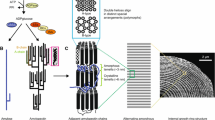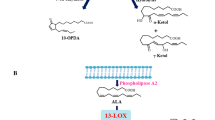Abstract
The current discussion on “renewable resources”, and the possibility of gene transfer into rapeseed, has led to many investigations into the biosynthetic pathways leading to industrially useful fatty acids. The various tribes and genera of the plant familyRanunculaceae contain a large variety of unusual fatty acids. Seed fatty acid patterns differ considerably from genus to genus and are chemotaxonomically significant indicators.Eranthis seed oil has now been found to contain a fatty acid pattern that deviates significantly from the eleven different fatty acid patterns that had been described in this plant family. The main fatty acid (up to 57%) is 13-cis, 16-cis-docosadienoic acid. Other, minor fatty acids found are Δ5-cis-monoenoic,-dienoic, and-trienoic fatty acids that had already been reported to be constituents of the genus-specific seed oil fatty acid patterns of various genera from this plant family. Capillary gas-liquid chromatographic retention data indicate that 22:3Δ5cis, 13cis, 16cis is probably also present. Seed fatty acid chemotaxonomic evidence thus points to a different position ofEranthis within the tribes of this plant family. These findings again indicate that the plant familyRanunculaceae would be an ideal object to study fatty acid biosynthesis and phylogenetic evolution, because in other genera of this family other types of desaturation and chain elongation mechanisms predominate.
Similar content being viewed by others
Abbreviations
- ECL:
-
equivalent chain length
- GC/MS:
-
gas chromatography/mass spectrometry
- GLC:
-
capillary gas-liquid chromatography
- RRT:
-
relative retention time
References
Murphy, D.J. (1994)Designer Oil Crops, VCH Weinheim, NY, Basel, Cambridge.
Ohlrogge, J.B. (1994) Design of New Plant Products: Engineering of Fatty Acid Metabolism,Plant Physiol, 104, 821–826.
Aitzetmüller, K., and Tsevegsüren, N. (1994) Seed Fatty Acids, “Front-End”-Desaturases and Chemotaxonomy—A Case Study in the Ranunculaceae,J. Plant Physiol 143, 538–543.
Aitzetmüller, K. (1995) Fatty Acid Patterns of Ranunculaceae Seed Oils: Phylogenetic Relationships,Plant Syst. Evol. [Suppl.] 9, 229–240.
Aitzetmüller, K. (1993) Capillary GLC Fatty Acid Fingerprints of Seed Lipids—A Tool in Plant Chemotaxonomy?,J. High Resol. Chromatogr. 16, 488–490.
Aitzetmüller, K., Werner, G., and Tsevegsüren, N. (1993) Screening of Seed Lipids for γ-Linolenic Acid: Capillary Gas-Liquid Chromatographic Separation of 18∶3 Fatty Acids with Δ5 and Δ6 Double Bonds,Phytochem. Anal. 4, 249–255.
Tsevegsüren, N., and Aitzetmüller, K. (1993) γ-Linolenic Acid inAnemone spp. Seed Lipids,Lipids 28, 841–846.
Aitzetmüller, K., and Tsevegsüren, N. (1994), Occurrence of γ-Linolenic Acid inRanunculaceae Seed Oils,J. Plant Physiol. 143, 578–580.
Smith, C.R., Kleiman, R., and Wolff, I.A. (1968)Caltha palustris L. Seed Oil. A Source of Four Fatty Acids withcis-5-Unsaturation,Lipids 3, 37–42.
Kaufmann, H.P., and Barve J. (1965) Über das Samenöl vonAquilegia vulgaris, Fette, Seifen, Anstrichm. 67, 14–16.
Takagi, T., Itabashi, Y., Kaneniwa, M., and Mizukami, M. (1983)Trans-5-Olefinic Unusual Fatty Acids in Seed Lipids ofAquilegia, Yukagaku 32, 367–374.
Aitzetmüller, K., and Werner, G. (1991) Stearidonic acid (18:4ω3) inPrimula florindae, Phytochem. 30, 4011–4013.
DGF (1987)Deutsche Einheitsmethoden zur Untersuchung von Fetten, Fettprodukten und verwandten Stoffen: Methode C-VI 11 a (81), Wissenschaftliche Verlagsanstalt, Stuttgart.
Yamamoto, K., Shibahara, A., Nakayama, T., and Kajimoto, G., (1991) Determination of Double-Bond Positions in Methylene-Interrupted Dienoic Fatty Acids by GC-MS as Their Dimethyl Disulfide Adducts,Chem. Phys. Lipids 60, 39–50.
Francis, G.W. (1981) Alkylthiolation for the Determination of Double-Bond Position in Unsaturated Fatty Acid Esters,Chem. Phys. Lipids 29, 369–374.
Zhang, J.Y., Yu, Q.T., Liu, B.N., and Huang, Z.H. (1988) Chemical Modification in Mass Spectrometry. IV—2-Alkenyl-4,4-Dimethyloxazolines as Derivatives for the Double-Bond Location of Long-Chain Olefinic Acids,Biomed. Environm. Mass Spectrom. 15, 33–44.
Ackman, R.G., and Hooper, S.N. (1973) Additivity of Retention Data for Ethylenic Functions in Aliphatic Fatty Acids. II. Polar Liquid Phases,J. Chromatogr. 86, 83–88.
Jamieson, G.R. (1970) Structure Determination of Fatty Esters by Gas-Liquid Chromatography, inTopics in Lipid Chemistry, Vol. 1 (Gunstone, F.D., ed.) Logos Press, London, pp. 107–159.
Smith, C.R. (1970) Occurrence of Unusual Fatty Acids in Plants, inProg. Chem. Fats Other Lipids, Vol. XI (Holman, R.T., ed.) Pergamon Press, Oxford, pp. 137–177.
Takhtajan, A. (1987)Systema Magnoliophytorum, Izd. Nauka, Leningrad.
Jensen, U., Hoot, S.B., Johansson, J.T., and Kosuge, K. (1995) Systematics and Phylogeny of theRanunculaceae—a Revised Family Concept on the Basis of Molecular Data,Plant Syst. Evol. [Suppl.] 9, in press.
Jensen, U. (1968) Serologische Beiträge zur Systematik der Ranunculaceen,Bot. Jahrb. 88, 204–310.
Tamura, M. (1993)Ranunculaceae, inThe Families and Genera of Vascular Plants (Kubitzki, K., ed.), Vol. 2, Springer, Berlin, pp. 563–583.
MacKenzie, S.L., and Taylor, D.C. (eds.) (1993)Seed Oils for the Future, AOCS Press, Champaign.
Author information
Authors and Affiliations
About this article
Cite this article
Aitzetmüller, K. An unusual fatty acid pattern inEranthis seed oil. Lipids 31, 201–205 (1996). https://doi.org/10.1007/BF02522621
Received:
Revised:
Accepted:
Issue Date:
DOI: https://doi.org/10.1007/BF02522621




